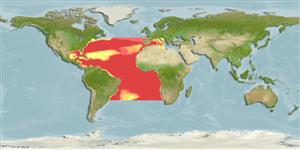>
Anguilliformes (Eels and morays) >
Nettastomatidae (Duckbill eels)
Etymology: Nettastoma: Greek, netta = duck + Greek, stoma = mouth (Ref. 45335); melanura: From the Greek melan meaning black, dark, and oura meaning tail, referring presumably to the dark edges of the posterior part of the dorsal and anal fins..
More on author: Rafinesque.
Environment: milieu / climate zone / depth range / distribution range
Écologie
marin bathypélagique; profondeur 0 - 1647 m (Ref. 4454), usually 329 - 860 m (Ref. 47377). Deep-water; 45°N - 30°S, 98°W - 17°E
Eastern Atlantic: Portugal to the Gulf of Guinea including western Mediterranean. Western Atlantic: Gulf of Mexico to the Guianas and to southern Brazil (Ref. 47377).
Length at first maturity / Taille / Poids / Âge
Maturity: Lm 53.5, range 42 - 68.2 cm
Max length : 79.8 cm TL mâle / non sexé; (Ref. 96016); poids max. publié: 255.50 g (Ref. 96016)
Vertèbres: 190 - 210. Usually five supratemporal pores, SO5 absent. Lateral line pores 43-49. Median vomerine teeth somewhat enlarged. Posterior nostril near anterodorsal margin of eye.
Occurs in holes on muddy bottoms of continental slope. Feeds mainly on crustaceans (Ref. 4776). Minimum depth reported taken from Ref. 86942.
Smith, D.G., 1990. Nettastomatidae. p. 172-175. In J.C. Quero, J.C. Hureau, C. Karrer, A. Post and L. Saldanha (eds.) Check-list of the fishes of the eastern tropical Atlantic (CLOFETA). JNICT, Lisbon; SEI; Paris; and UNESCO, Paris. Vol. 1. (Ref. 4454)
Statut dans la liste rouge de l'IUCN (Ref. 130435)
Menace pour l'homme
Harmless
Utilisations par l'homme
Pêcheries: sans intérêt
Outils
Articles particuliers
Télécharger en XML
Sources Internet
Estimates based on models
Preferred temperature (Ref.
123201): 5.4 - 14.4, mean 10.2 °C (based on 488 cells).
Phylogenetic diversity index (Ref.
82804): PD
50 = 0.5312 [Uniqueness, from 0.5 = low to 2.0 = high].
Bayesian length-weight: a=0.00095 (0.00067 - 0.00137), b=2.95 (2.85 - 3.05), in cm total length, based on LWR estimates for this species (Ref.
93245).
Niveau trophique (Ref.
69278): 3.5 ±0.50 se; based on food items.
Résilience (Ref.
120179): Faible, temps minimum de doublement de population : 4,5 à 14 années (Assuming tmax>10).
Fishing Vulnerability (Ref.
59153): Moderate to high vulnerability (52 of 100).
Nutrients (Ref.
124155): Calcium = 12.3 [2.9, 50.7] mg/100g; Iron = 0.319 [0.093, 1.082] mg/100g; Protein = 18.2 [15.8, 20.8] %; Omega3 = 0.172 [0.056, 0.548] g/100g; Selenium = 15.7 [4.0, 65.6] μg/100g; VitaminA = 13.5 [1.5, 108.4] μg/100g; Zinc = 0.42 [0.19, 1.05] mg/100g (wet weight);
